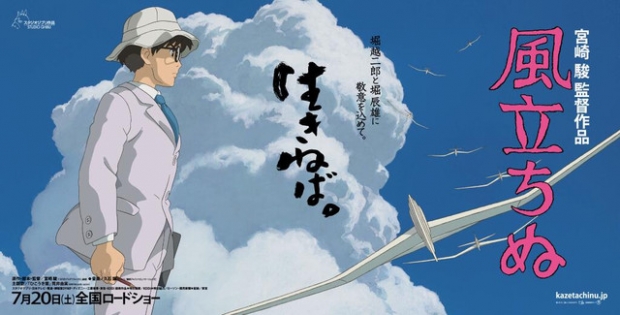
Kids who see The Wind Rises will be disappointed. They’ll shake their tiny hands at the nearest parent and whine: “You lied! This isn’t by the Ponyo and Totoro guy! It’s too serious!” Then a fantastical sequence will capture their full attention...for a flicker. Meanwhile, adults will be mesmerized by a nuanced and masterfully told World War 2 tale that is one-part Miyazaki, one-part Grave of the Fireflies.
Jiro Horikoshi, based on a real-life person of the same name, doesn’t have much of a personality. He’s a hard-working, mild-mannered engineer who spends all his time designing airplanes. He’d love to fly them too, but his thick glasses put an end to that idea long ago. When Jiro eats a piece of mackerel, the bone inspires an idea for wing design. When he sleeps, he sees a famous, mustachioed Italian engineer who offers sage advice. World War 2 brews somewhere in the background, but Jiro, gainfully employed, is far from the front lines. The sad irony is that everything this earnest young man creates will be used to destroy.
The Wind Rises flows through Jiro’s life like a dream, with loose, broad-strokes direction. You’ll lose your place a few times and often wonder how much time has passed, where the locations are or whether you’re watching reality or a dream sequence. It’s slightly disorienting but works because it reinforces the films nostalgic feel. Speaking of which…
Hayao Miyazaki claims that The Wind Rises is his last movie. He’s “resigned” before, but this time it feels real. The Wind Rises is what you’d expect from a retiring auteur: personal, semi-autobiographical and nostalgic. Watching the film, you can’t help but substitute Miyazaki in for the lead protagonist. What mentor figure did he dream about in his youth? Osamu Tezuka? Roald Dahl? In one scene the mentor compares an artist’s struggles with an engineer’s, commenting that both have 10 years of good creativity within them. An odd statement considering Miyazaki has been productive for decades longer than that! Miyazaki grew up around planes--his dad was an important figure in WW2 plane development--so the choice of a creative plane designer as protagonist was personal.
Many of Miyazaki’s films are fantasy stories with realistic undertones. Even the cheerful My Neighbor Totoro hides references to a tragic Japanese incident (Google it!). The Wind Rises is the opposite: it’s historical first and surreal second. Miyazaki didn’t want to cloud the anti-war message in any way, especially at a time when the Japanese government was debating remilitarization. (It’d be hard for mainstream audiences to take The Wind Rises seriously if, like his other movies, it featured witches and talking animals.) The surreal elements are still needed to keep the movie from being too much of a History Channel experience. Charming Ghibli touches (a character’s silly hair, another character’s silly salad, the dreams) bridge together and soften long stretches of reality.
The most successful part of The Wind Rises is how it depicts World War 2. Jiro lives in comfort, but he drives through streets overcome with poverty. He doesn’t see the destruction of war, but he’s almost killed by an apocalyptic earthquake that looks a lot like a bombing. He doesn’t experience Nazi horrors, but he ominously learns that his favorite German engineer is in “trouble” with Hitler. The movie treats World War 2 kind of like how Jaws treats its great white shark--always hinting.
The vast majority of you will see The Wind Rises no matter what. That’s brilliant. Just don’t go in expecting a traditional Ghibli experience. This is an intellectual film that’ll require focus, repeat viewings and much thought and discussion to fully digest. You might get a little weary or depressed at times, but you’ll be satisfied by the overall experience. The title of the film is the first half of a French saying: ”The wind rises, we must try to live.” Miyazaki now leaves us, we must try to make do...
theO Score: 10/10

